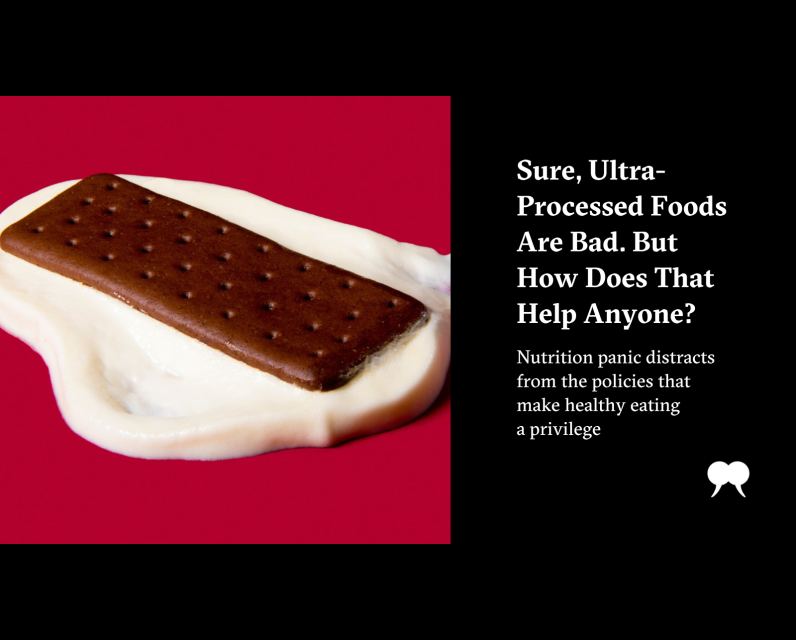Sure, Ultra-Processed Foods Are Bad. But How Does That Help Anyone?

Cards on the table: I’m a champion of healthy eating, and ultra-processed foods (UPFs) have never been my thing. My instincts and long-held beliefs make it easy to accept the idea of UPFs as a public health menace. And there have been plenty of stats and headlines to feed that bias.
A 2024 review of available research identified thirty-two studies linking UPFs to a higher risk of health conditions, including heart disease, cancer, diabetes, and obesity. More recent research found a dose response between UPFs and mortality (the more you eat, the more likely you will die early). The study estimated that 14 percent of premature deaths in the United Kingdom and the United States were “attributable to ultra-processed food intake.”
Other studies have suggested that UPFs could mess with our gut microbiome, mental health, and sleep. And because UPFs heavily rely on a few high-yielding crops—varieties of corn, wheat, soy, and sugarcane bred for mass production—they may also have an adverse impact on biodiversity and the environment.
So, all in all, the emerging research paints a pretty ghastly picture, especially when you consider that UPFs account for almost half of Canadians’ daily calories. A study from the US found that a shocking 67 percent of calories consumed by youth aged two to nineteen come from UPFs.
It’s grim stuff, but the reality isn’t so simple. Villainizing UPFs flattens a debate shaped by messy science and tangled policy. The real trouble, it seems, begins long before the products ever hit the shelves.
Let’s start with the definition. For most of us, “UPFs” is likely just a fancy term for “junk food.” Cheap and tasty. Oreos, soda pop, and Slim Jims. For the research community, which needs more exactitude than “junk,” the most commonly used definition—which comes from the Nova food classification system—focuses on “industrially created food products” that contain ingredients rarely found in home cooking.
But this (only slightly) more specific classification remains overly broad. It captures UPFs that, as noted in a recent New England Journal of Medicine commentary, are “made with more healthful, less-processed ingredients—such as whole grains, fruits, vegetables, legumes, or yogurt.” Because these foods (e.g., breakfast cereals, frozen veggies, canned baked beans, pre-packaged whole-grain bread) can be mass produced, they may contain products that categorize them as UPFs. But these UPFs, the author notes, “generally have neutral or positive health associations.” Indeed, research has shown that particular UPFs are more harmful than others, such as “animal-based products and artificially and sugar-sweetened beverages.”
So, are all UPFs, as currently categorized, bad? No.
Because of these kinds of definitional problems, researchers are scrambling (and mostly failing) to find a more precise description to both inform the development of coherent regulatory responses and improve research methods. For example, should we really focus on processing, as outlined by Nova and supported by food journalist Tamar Haspel, as the key proxy of badness? Perhaps zeroing in on the energy density of processed food—that is, how many calories are packed into each bite—would make more practical sense, as at least a few studies suggest.
A 2025 study found that many people are unclear what the term “processed food” applies to. For example, “most young participants failed to identify processed meat as a processed food.” Therefore, the study authors suggest that “the vague term processed foods should be replaced by more specific terms describing foods’ known health effects.”
In fact, despite all the headlines associated with UPFs, very few studies have explored the causal effects of UPFs on health. The bulk of the research on the subject are association studies—some large and very well done, but still correlational in nature—that can’t definitively conclude that UPFs are the direct cause of particular health problems. In other words, might the consumption of UPFs be a marker for some other behaviour or circumstance that is producing or contributing to the health issues?
And even if UPFs, however defined, were shown to be a key health-crushing culprit, what is it about UPFs that makes them so bad? Short answer: research is emerging, but we’re still not entirely sure.
As is often the case with health issues, socioeconomics looms large. Studies, including recent research from Canada, have found that UPFs are most heavily consumed by those with lower education and income. That’s crucial context. Socioeconomic circumstances are strongly correlated with health and thus an important complicating factor (i.e., it isn’t the food that’s making people sick; it’s the poverty). And because UPFs tend to be the most affordable and widely available options, any policy that cracks down on them risks hitting the poorest families hardest.
Perhaps the biggest challenge with UPFs is at the level of policy making. Simply put, we don’t know which policies will work to make us healthier. Do we police the marketing of UPFs? Do we restrict the use of certain processing techniques? Do we—and this is assuming we’ve agreed on a conceptually coherent definition—label products that contain UPFs? Regulating food and its consumption is notoriously tricky.
A recent study found that nearly 86 percent of proposed strategies to regulate UPFs focus on changing behaviour rather than addressing the broader food system. Most rely on labels or public awareness campaigns aimed at nudging consumers toward healthier choices. But rewriting habits is a daunting task. A 2024 study found that UPF warning labels have little effect. Public health strategies that rely on individual willpower are politically appealing because they shift responsibility away from industry and onto individuals. The problem? They’re far less effective than policies that reshape conditions around eating, like curbing junk food ads or making healthy options easier to access, such as by operating school meal programs or tackling food deserts.
Policies that emphasize individual choice also tend to be less equitable. If non-UPF alternatives are too expensive or hard to find, then making healthier decisions simply isn’t realistic. As noted by Paul Coleman, a research fellow at the University of Warwick who studies food policy and the social determinants of health, “For low-income parents there is little option but to buy these unhealthy options, even when they know they are bad for their child’s health. The low-cost and long-shelf of unhealthy snacks make them the most logical option.”
To make matters worse, from the regulatory standpoint, UPFs are part of a complicated multi-trillion-dollar food ecosystem that rewards the creation, marketing, and sale of cheap and highly palatable products. Directly regulating such a massive, powerful, and multi-sector part of the economy will be a challenge for any government, regardless of its ideological bent. Are the Liberals really going to, for example, ban the sale of Froot Loops?
What makes this even more complicated is that feeding a growing global population sustainably will likely require efficient and large-scale approaches to agriculture. That doesn’t have to mean more UPFs, but unless we see major changes in market incentives, consumption patterns, and production practices, there will likely be real tension between health and sustainability goals.
The current focus on UPFs is understandable. And there is a growing body of evidence highlighting their potential to cause serious harm. As noted, I’m a fan of any science-informed trends that emphasize real food and healthy eating habits. Waiting for the perfect amount of evidence can do harm. We need to act, both nationally and internationally, to improve diets and the food environment.
But oversimplifying the nature of the problem by creating one big bogeyman can also cause harm. It can muddle our understanding of what healthy eating looks like, shift blame to the wrong people, and pave the way for policies that don’t work and aren’t fair.
I recognize that “it’s complex” isn’t much of a hot take. But sometimes it is, well, complex.
The post Sure, Ultra-Processed Foods Are Bad. But How Does That Help Anyone? first appeared on The Walrus.

Comments
Be the first to comment